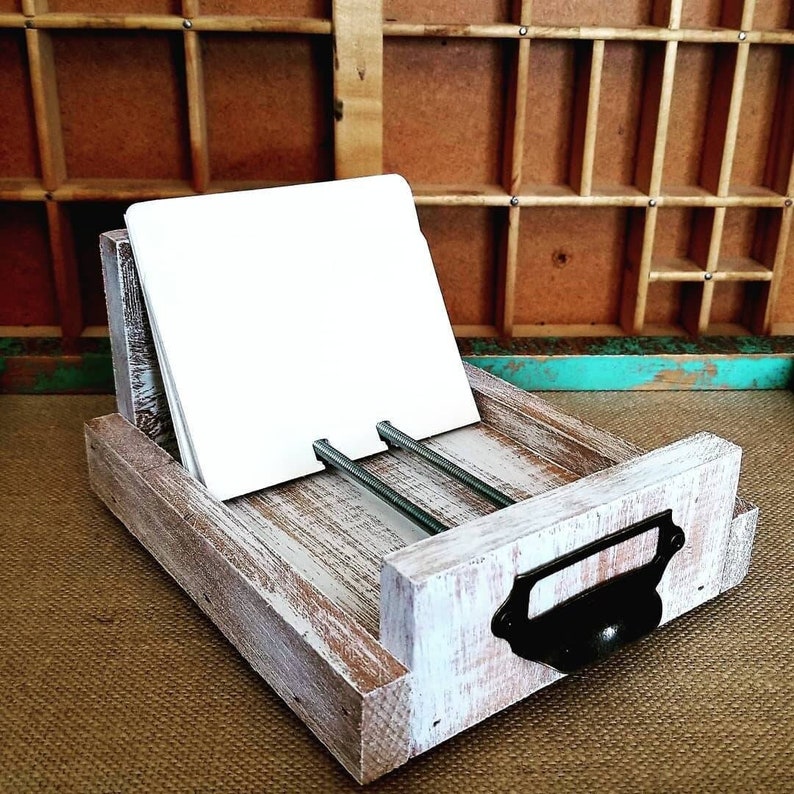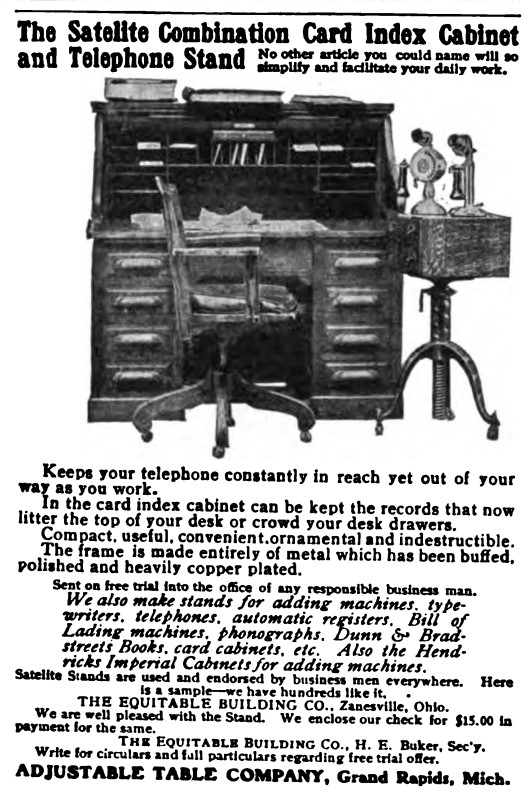Typing on Small Cards by [[Joe Van Cleave]]
- Apr 2025
-
www.youtube.com www.youtube.com
Tags
Annotators
URL
-
- Apr 2024
-
www.ebay.com www.ebay.com
-
Rolodex Item #67380 https://www.ebay.com/itm/166733559184
You have to appreciate the way that this zettelkasten is designed to be decorative and include personal family photos almost as a representation of what it directly contains.
 Caption: A small rolodex file in grey and black plastic with a picture frame on the front with space for a small photo, in this case either a picture of a young child or a family dog
Caption: A small rolodex file in grey and black plastic with a picture frame on the front with space for a small photo, in this case either a picture of a young child or a family dog
-
- Mar 2024
-
Local file Local file
-
163
Early 20th century mail merge using a card index!
-
- Feb 2024
-
Local file Local file
-
Would it bestretching things too much, you suddenly wonder, to call yourRolodex a form of autobiography—a manuscript that you have beenwriting these �fteen years, tinkering with, revising?
-
- Apr 2023
-
www.etsy.com www.etsy.com
-
Decorative boxes with Rolodex like bars for keeping memories on a desk.

-
-
-
Memindex Phondex Office Phone Number Organizer Styrene NOS
Memindex, Inc. of Rochester, NY manufactured a plastic "Phonedex" in the mid-20th century. It was made of Dow Chemical Styrene and sat underneath a standard rotary dial telephone and contained index cards with one's lists of phone numbers on them.

-
- Mar 2023
-
-
TheSateliteCombinationCard IndexCabinetandTelephoneStand

A fascinating combination of office furniture types in 1906!
The Adjustable Table Company of Grand Rapids, Michigan manufactured a combination table for both telephones and index cards. It was designed as an accessory to be stood next to one's desk to accommodate a telephone at the beginning of the telephone era and also served as storage for one's card index.
Given the broad business-based use of the card index at the time and the newness of the telephone, this piece of furniture likely was not designed as an early proto-rolodex, though it certainly could have been (and very well may have likely been) used as such in practice.
I totally want one of these as a side table for my couch/reading chair for both storing index cards and as a temporary writing surface while reading!
This could also be an early precursor to Twitter!
Folks have certainly mentioned other incarnations: - annotations in books (person to self), - postcards (person to person), - the telegraph (person to person and possibly to others by personal communication or newspaper distribution)
but this is the first version of short note user interface for both creation, storage, and distribution by means of electrical transmission (via telephone) with a bigger network (still person to person, but with potential for easy/cheap distribution to more than a single person)
Tags
- user interface
- postcards
- intellectual history
- card index filing cabinets
- satelite stands
- zettelkasten boxes
- Grand Rapids Michigan
- technology
- evolution of technology
- Adjustable Table Company
- audience
- telegraph
- telephones
- card index for business
- office furniture
- annotations
- rolodexes
Annotators
-
-
www.ebay.com www.ebay.com
-
1930s Wilson Memindex Junior Index Card Box Pre Rolodex Ad Price List Brochure
Note that the seller mistakenly lists it as a pre-rolodex!
Good photos including a list of supplies and prices:

A description of roughly how the Memindex system works:

Page archive: https://web.archive.org/web/20230310002530/https://www.ebay.com/itm/165910053313
-
- Jan 2023
-
www.reddit.com www.reddit.com
-
What's this trick with the knitting needle? It sounds cool. How do you do it so you don't just run into the unpunched ones and get stopped?
reply to u/stjeromeslibido at https://www.reddit.com/r/antinet/comments/10lqfsn/comment/j63y2k9/?utm_source=reddit&utm_medium=web2x&context=3
Every card has holes pre-punched into it in exactly the same place (see the photo in the original post at the top) so that one might put a knitting needle (or other thin instrument) through the whole deck in each of the positions. Then one should decide on what each hole's meaning will be by position.
As an example, imagine you're using your cards in a rolodex fashion and you want to distinguish the six categories: family, friends, service providers, neighbors, co-workers, and organizations/businesses. For family members you cut/remove the additional paper between the first hole (representing "family") and the edge of the paper. You do the same thing for all the other cards based on their respective categories. So, for example, your brother Joe who lives across the street from you and works with you at the office in the family business would have cuts removed for positions 1, 4, and 5. For an entity that fits all six categories, cuts would be made such that the sheet would no longer stay in u/I-love-teal (the original poster's) six ring binder notebook.
At the end of the year you want to send Christmas cards to your friends, family and neighbors, so you put the knitting needles into position 1 and pull up separating your family out, then you repeat for positions 4 and 5 until you have your full list. (Pro tip: you probably wouldn't want to pull them out of the deck completely, but might rather pull them up and set them at a 90 degree angle thus preventing you from needing to do the work of refiling them all in a particular order.)
Obviously if you have multi-row edge punches or dozens of edge notches you can discern a lot more categories or data types using basic logic. Just abstract this to your particular note card system. Herman Hollerith used this in early versions of the U.S. Census in the late 1800s and it and variations were used heavily in early computer programming applications.
A variation of this sort of trick can also be done by coloring in (or not) the edges of parts of your cards as well. See for example the general suggestions in these photos which help to layout the idea of the "Pile of Index Card" system used back in 2006 with respect to Getting Things Done (GTD) philosophy:
- https://www.flickr.com/photos/hawkexpress/189967397/
- https://www.flickr.com/photos/aki_oda/2684257358
- https://www.flickr.com/photos/hawkexpress/189972896
On my mathematics specific notes which I generally put on graph paper cards, I use colored edge "notches" like these to represent broad categories like theorems, proofs, definitions, corollaries, etc. or method of proof (induction, direct, contradiction, contraposition, construction, exhaustion, probabilistic, combinatorial, etc.) This makes finding specific cards a bit easier as I tip through various sections.
A historian might use colored edges to visually label dates by decades or centuries depending on the timespan of their studies. The uses can be endless and can be specific to your field of study or needs.
Some might also attach the idea of tags/categories to the colors of their cards, so you might use white cards for ideas which are your own, yellow cards which are quotes of others' material, blue cards which represent synopses of other's ideas, etc. One might also profitably use a multi-pen with different colored inks to represent these sorts of meta-data as well.
The variations are endless...
-
-
forum.zettelkasten.de forum.zettelkasten.de
-
Anybody using this approach to manage contacts? How?
reply to IvanFerrero at https://forum.zettelkasten.de/discussion/1740/anybody-using-this-approach-to-manage-contacts-how#latest
Many of the digital note taking tools that run off of text allow you to add metadata to your basic text files (as YAML headers, inline with a
key:: valuepair, or via #tags). Many of them have search functionality or use other programmatic means like query blocks, DataView, DataViewJS, etc. for doing queries on your files to get back lists, tables, charts, etc. of the data you're looking for.The DataView repository has some good examples of how this works with something like Obsidian. Fortunately if you're using simple text files you can usually put them into one or more platforms to get the data and affordances you want out of them individually.
As an example, I have a script block in my daily note in Obsidian for birthdays in my notes that fall on today's date:
```dataview LIST birthday FROM "Lists/People" WHERE birthday.day = date(2023-01-18).day ```If I put the text
birthday:: 1927-12-08into a note about Niklas Luhmann, his name and birthday would appear in my daily note on his birthday. One can use similar functionality to create tables of books they read with titles, authors, ratings, dates read, etc. or a variety of other data input which parses through your plaintext files. Services like Obsidian, Logseq, et al. are getting better about allowing these types of programmatic searches for users without backgrounds in programming and various communities usually provide help for pre-made little snippets like the one above that one can cut and paste into their notes to get the outputs that they need. Another Obsidian based example that uses text files for tracking academic journal articles can be found at https://nataliekraneiss.com/your-academic-reading-list-in-obsidian/; I'm sure there are similar versions for other text-based platforms.In pre-digital times, for a manual version of a rolodex like this in paper, one could use different color cards as pseudo-tags (doctors are on yellow cards, family members on blue cards, friends on green cards, etc.) or adding edge notches or even tabs to represent different types of metadata. See for example the edge colored cards in Hawkexpress' Pile of Index Cards: https://www.flickr.com/photos/hawkexpress/albums/72157594200490122
-
-
-
-
https://clay.earth/story
generally meh, but nice link to
Tags
Annotators
URL
-